-
past events
End-of-year Bookshop Sale Dec 13, 2025 - Dec 20, 2025
Eve Aboulkheir Lampo Performance Series Dec 06, 2025 Performance
Leila Bordreuil and Lee Ranaldo Lampo Performance Series Nov 08, 2025
Roc Jiménez de Cisneros Lampo Performance Series Oct 11, 2025
Concepción Huerta Lampo Performance Series Sep 27, 2025 Performance
Madlener House
4 West Burton Place
Chicago, Illinois 60610
Telephone: 312.787.4071
info@grahamfoundation.org
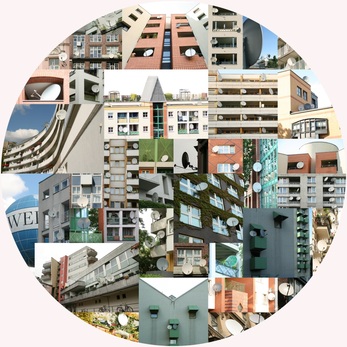
Esra Akcan, Freedom of Information (collage portraying International Building Exhibition (IBA) buildings, printed on satellite dish), Istanbul Design Biennale, 2012.
This talk will explore the International Building Exhibition (IBA’1984/87), which commissioned acclaimed architects from all over Europe and North America to transform the predominantly Turkish immigrant neighborhood Kreuzberg in Berlin. Architects brought in for the design of public housing projects included Aldo Rossi, Rob Krier, Oswald Matthias Ungers, Alvaro Siza, Rem Koolhaas, Peter Eisenman, Zaha Hadid, John Hejduk and many others. Akcan discusses this urban renewal project as a microcosm of the history of urban housing, a significant moment in the postmodernist and deconstructionist debates in architecture throughout the 1970s and 1980s, and an example of the attendant relationship between housing and international immigration policies. Using a narrative genre inspired by oral history and storytelling, Akcan gives voice not only to the architects and policy makers, but also to the immigrant inhabitants. Research related to this talk was recently featured in Akcan’s contribution to the Istanbul Design Biennale, 2012: “Urban Renewal and its Discontents: Kreuzberg—IBA ’84/87.”
Esra Akcan is an assistant professor in the Department of Art History at the University of Illinois at Chicago. She received her architecture degree from Middle East Technical University and her Ph.D. and postdoctoral degrees from Columbia University. She has taught at Columbia University, New School, Pratt Institute, METU, and Humboldt University. Akcan has received awards and fellowships from the Graham Foundation, the Institute for Advanced Studies in Berlin, the Clark Institute, the Getty Research Institute, the Canadian Centre for Architecture, the Mellon Foundation, DAAD, Kinne, and KRESS/ARIT. She is the author of Architecture in Translation: Germany, Turkey, and the Modern House (Duke University Press, 2012), Turkey: Modern Architectures in History (co-author Sibel Bozdoğan, Reaktion, 2012), (Land)Fill Istanbul (124/3, 2004), and Çeviride Modern Olan (YKY, 2009).
Following the lecture, both of Akcan’s recent books, published with the support of the Graham Foundation, Architecture in Translation and Turkey: Modern Architectures in History, will be available for purchase in the Graham bookshop.
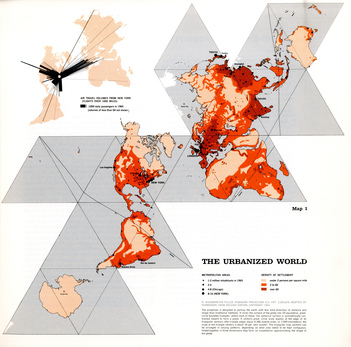
In what sense is the 21st century world urban? In this lecture, Neil Brenner critiques contemporary ideologies of the "urban age," which confront this question with reference to the purported fact that more than 50% of the world's population resides within cities. Against such demographic, city-centric understandings, Brenner excavates Henri Lefebvre's (1970) notion of generalized urbanization for conceptual and methodological insights into the 21st century planetary urban condition. He argues that the geographies of urbanization can no longer be conceptualized with reference to cities, metropolitan regions or even megalopolises, but today encompass diverse patterns and pathways across the planetary sociospatial landscape, from Manhattan to the Matterhorn, from the Pearl River Delta to Mount Everest, from the Nile River valley to the Pacific Ocean. This variegated urban fabric must become the focal point for new approaches to urban theory, strategies of collective intervention and imaginaries of built environments.
Neil Brenner is Professor of Urban Theory at the Harvard Graduate School of Design (GSD) and the coordinator of the newly founded Urban Theory Lab GSD. He previously served as Professor of Sociology and Metropolitan Studies, and as an affiliated faculty member of the American Studies Program at New York University. He holds a Ph.D. in Political Science from the University of Chicago (1999); an MA in Geography from UCLA (1996); and a BA in Philosophy from Yale College (1991).
This talk is co-presented by the Chicago Expander at Archeworks and the Graham Foundation.
The Chicago Expander at Archeworks aims to spatialize the formation of Chicago as a larger geographic entity and recasts the city and its region as a spatial model. The program is directed by Iker Gil and Antonio Petrov.
Archeworks is a multidisciplinary design educator that advances design in the public interest and inspires collaborative action to shape more healthy, sustainable and equitable communities.
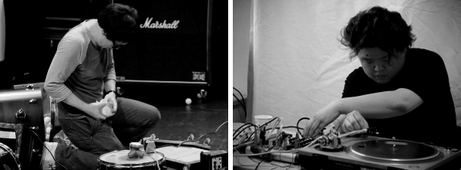
Lampo and the Graham Foundation are very pleased to welcome Choi Joonyong and Hong Chulki, two leading figures from the emerging experimental music community in Seoul. In their Chicago debut, they will perform together and alone, combining their individual interests in noise and improvised music: Choi's mobile performance, where he pushes an amplifier in and around the audience as though a noise vendor and Hong's pursuit of continuity between acoustic and amplified noise, using turntables with and without cartridge pickups.
Choi Joonyong (b. 1977) started Astronoise with Hong Chulki in 1997, and has been playing noise/experimental/improvised music since. Primarily using playback devices such as CD-player, MP3-player, tape player, VCR, or loud-speaker, Choi works with sounds from the mechanisms, exposing the innate qualities of the players themselves. He has released many albums, including five solo albums made with the malfunction of a CD-player. He is interested in control and failure of playing through improvisation and composition. Choi's label, Balloon & Needle, has released experimental music from Korea since 2000. His latest release, Danthrax features his unique approach to dance music.
Hong Chulki (b. 1976) is a noise/improvising musician from Seoul, South Korea, known for his cartridge-less turntable, and as the founding member of Astronoise, Korea's first live noise act (with Choi Joonyong). He has been focusing on free improvisation since the early 2000s, collaborating with musicians including Ryu Hankil, Jin Sangtae, Joe Foster, Kevin Parks, Otomo Yoshihide, Sachiko M, Jason Kahn, Takahiro Kawaguchi, Nick Hoffman, Robbie Avenaim and Zbigniew Karkowski. Festival appearances include All Ears, Against, Kitakyushu Biennale and NETMAGE 10, and he has been a musician in residence at Cafe Oto and STEIM. Hong has composed pieces for several Korean experimental/independent films, especially, Goksa (Kim Gok/Kim Sun). He also has been a long-time collaborator in the audio-visual performance project called Expanded Celluloid Extended Phonograph with the Korean film artist Lee Hangjun, who works in 16mm multi-projection performance. Hong's recordings both in solo and collaborative format have been released on his own label, Balloon & Needle, co-founded and co-run with Choi, and by Manual, Celadon, Pilgrim Talk, Hanson Records and Audition Records.
This performance is presented in partnership with Lampo. Founded in 1997, Lampo is a non-profit organization for experimental music, sound art and intermedia projects. Visit www.lampo.org.
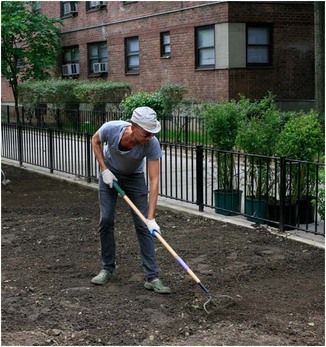
Photo: Oto Gillen.
Establishing a plant-animal-people trilogy with the Edible Estates (est. 2005) series of front yard food gardens and the Animal Estates (est. 2008) initiatives for urban wildlife architecture, Domestic Integrities (est. 2012) turns its attention inward to local patterns and rituals of interior domestic landscapes and the way we use what we resourcefully find around us to artfully make ourselves at home. “Domestic Integrity Fields” are charged sites—on crocheted rugs of discarded textiles—to test, perform, and present how we want to live. One rug in each continent gradually expands as it travels from city to city. In the United States, the series began during fall 2012 at the Museum of Modern Art and the new Broad Museum of Art at Michigan State University, followed by The Hammer Museum of Art in spring 2013, the deCordova Museum in the summer, and at the Walker Art Center in the fall. In Europe the project is taking place at Pollinaria in Abruzzo, Italy in 2012-2013.
In 2012, Haeg received a Graham Foundation grant for Edible Estate #12: Budapest, Hungary, produced with Blood Mountain Foundation. More about the project here.
On February 19, Haeg will speak on Architecture is Activism…FOOD!, a panel discussion hosted by the Chicago Architecture Foundation and supported by a grant from the Graham Foundation. More about the project here.
Fritz Haeg's work has included edible gardens, public dances, educational environments, animal architecture, domestic gatherings, urban parades, temporary encampments, documentary videos, publications, exhibitions, websites, and occasionally buildings for people. Recent projects include Sundown Schoolhouse, an itinerant educational program; Edible Estates, an international series of domestic edible landscapes; and Animal Estates, a housing initiative for native animals in cities around the world which debuted at the 2008 Whitney Biennial. Haeg is a 2010-2011 Rome Prize Fellow and has taught in architecture, design, and fine art programs at Princeton University, Cal Arts, Art Center College of Design, Parsons School of Design, and the University of Southern California. Haeg has produced projects and exhibited work at MoMA; Tate Modern; the Hayward Gallery; the Liverpool Biennial; the Whitney Museum of American Art; SFMoMA; SALT Beyoglu, Istanbul; Casco, Utrecht; Stroom, Den Haag; Arup Phase 2, London; Blood Mountain Foundation, Budapest; The Indianapolis Museum of Art; Mass MoCA; The Institute of Contemporary Art, Philadelphia; among others. Recent books include The Sundown Salon Unfolding Archive (Evil Twin Publications, 2009), Edible Estates: Attack on the Front Lawn (Metropolis Books, 2nd ed., 2010), and Roma Mangia Roma (Nero, expected Spring 2013).
Edible Estate #12
http://grahamfoundation.org/grantees/4831-edible-estate-12-budapest-hungary
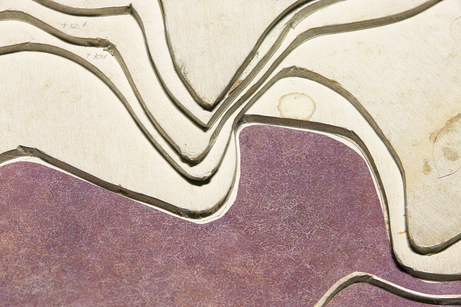
Thomas Demand, Beyer #34, 2011, Pigment Print, 41.9” x 63.0”© Thomas Demand, VG Bild-Kunst, Bonn / DACS, New York. Courtesy Esther Schipper, Berlin / Matthew Marks Gallery, New York / Sprüth Magers Berlin London.
Please join us to celebrate the opening of Model Studies: Thomas Demand with Fernand Léger, Francis Bruguière, Thomas Scheibitz, and the VKhUTEMAS School. The exhibition will open with remarks from Thomas Demand and Graham Foundation director Sarah Herda followed by a reception.
6PM Opening remarks with Thomas Demand and Sarah Herda
6-8PM Opening Reception
For more information on the exhibition, Model Studies, click here.
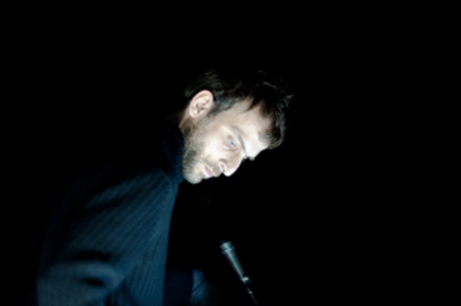
On March 30, Berlin-based composer and sound installation artist Valerio Tricoli offers a special program for Lampo to mark the 100th anniversary of Luigi Russolo's Futurist manifesto, The Art of Noises (March, 1913). Russolo’s manifesto introduced the idea of noise-sound into musical discourse, creating the conditions for radical advancements in sonic art and informing movements in musique concrète, electronic music, and the practices of American experimental composers such as John Cage. In the essay, Russolo lays the foundation for a new music based on what he calls ‘Futurist noise-sound,’ claiming that all sounds of life—whether natural or derived from man-made devices or machines—should be incorporated into music. He also strongly encourages the development and design of new instruments capable of producing new kinds of noises suitable to the mise en être of the expanded acoustic imagination of the composer. Russolo himself, some months after the publication of the manifesto, would present his own Intonarumori (Noise-tuners).
This Lampo program will be divided in two parts: first, An Homage to Luigi Russolo, a live electro-acoustic improvisation for electronic devices, self-built instruments, found sounds, and voice, to be followed by La Solidità Della Nebbia, a multi-channel diffusion of the tape composition.
Valerio Tricoli (b. 1977, Palermo, Italy) is a Berlin-based composer, improviser, producer, sound installation artist, sound engineer, and curator bridging musique concrète and conceptual forms of sound with a radical interest in how reality, virtuality, and memory relate to each other during the acoustic event. He mostly uses analogue electronic devices including reel-to-reel tape recorders, synthesizers, microphones, light effects, and ultrasonic speakers. However, the structure of the setup is ever-changing, seeking multiple relations between the performers, the device, and the space in which the event takes place. Tricoli is one of the founders of 3/4HadBeenEliminated and the Bowindo label / collective. In 2012, he presented a new interpretation of the seminal 1952 John Cage electro-acoustic tape piece Williams Mix with Werner Dafeldecker, which premiered at Maerz Musik, Berlin. He is currently working on two compositions for piano and electronic sounds (with Anthony Pateras) and on a concrete music cycle inspired by the Book of Qohelet. Tricoli made his U.S. debut at Lampo in March 2008, when he performed Take Thy Horoscope and Walk, a multi-sensorial set of live concrete music in quad sound with strobe lights.

Institute of Contemporary Art Boston by Diller Scofidio + Renfro. Photograph by Nic Lehoux.
Architecture and film scholar Edward Dimendberg discusses his Graham-funded book Diller Scofidio + Renfro: Architecture after Images (University of Chicago Press, 2013), the first full-length critical chronological monograph on the work of the New York-based architecture studio known for its integration of visual art, multimedia, and performance into its buildings and urban projects. Book signing and reception to follow the presentation.
Edward Dimendberg is professor of film and media studies, visual studies, and European languages and studies at the University of California, Irvine and the principal of Dimendberg Consulting LLC. He is the author of Film Noir and the Spaces of Modernity (2004), also supported by the Graham Foundation, and the co-editor of The Weimar Republic Sourcebook (1994).

Robert Rauschenberg creating the combine 'Gold Standard in Twenty Questions to Bob Rauschenberg,' Sogetsu Art Center, Tokyo, November 28, 1964. Photograph by Masaaki Sekiya. ©2011 Masaaki Sekiya. All rights reserved. Courtesy of the Solomon R. Guggenheim Museum, NY.
Please join us for a panel discussion exploring the emerging role of artist-endowed foundations as a force in cultural philanthropy and in the stewardship of contemporary art and design.
Research conducted by the Aspen Institute's National Study of Artist-Endowed Foundations, the first effort to examine the field of private foundations endowed by visual artists in the U.S., has documented more than 355 foundations, many created in the past two decades, holding $3.5 billion in assets, $2 billion of this in the form of art and intellectual property. With higher profile foundations bearing names such as Lichtenstein, Warhol, and Rauschenberg, these organizations make grants to nonprofits and to artists and scholars. They steward art collections and archives, contribute artwork to museums, operate artist residency centers, care for architecturally significant properties, and conduct cultural and educational programs. In 2010, members of the field made $70 million in aggregate grants. Among key trends documented by the Study is a rise in the number of foundations associated with architects and designers. The Study’s report may be viewed online at www.aspeninstitute.org/psi/a-ef-report.
Panelists include Sarah Herda, Director of the Graham Foundation for Advanced Studies in the Fine Arts and former director/curator of the Storefront for Art and Architecture; Christy MacLear, Executive Director of Robert Rauschenberg Foundation and former inaugural director of the Philip Johnson Glass House, a property of the National Trust for Historic Preservation; Stephen K. Urice, Professor of Law, University of Miami School of Law, and co-author of the standard art law casebook, Law, Ethics and the Visual Arts, Kluwer Law International (5th Ed. 2007); and Christine J. Vincent, Study Director, The Aspen Institute’s National Study of Artist-Endowed Foundations and former deputy director for media, arts and culture at the Ford Foundation. The panel will be moderated by Angelique Power, Senior Program Officer, Culture, the Joyce Foundation.
The Graham Foundation for Advanced Studies in the Fine Arts was created in 1956 by a bequest from architect Ernest R. Graham (1866–1936). The Foundation makes project-based grants to individuals and organizations and produces public programs to foster the development and exchange of diverse and challenging ideas about architecture and its role in the arts, culture, and society. The Foundation’s programs can be viewed online at www.grahamfoundation.org.
Robert Rauschenberg Foundation was formed by Robert Rauschenberg (1925-2008) in 1990 to promote awareness of the causes and groups close to his heart. Activities of the Foundation include managing the artwork, exhibition and scholarship of Robert Rauschenberg as well as the growth of the philanthropy programs that intersect art and issues central to the artist’s concerns during his lifetime. The Foundation’s programs are detailed online at www.rauschenbergfoundation.org
The Aspen Institute’s National Study of Artist-Endowed Foundations has been supported by a consortium of national and regional donors whose members include the Joyce Foundation.
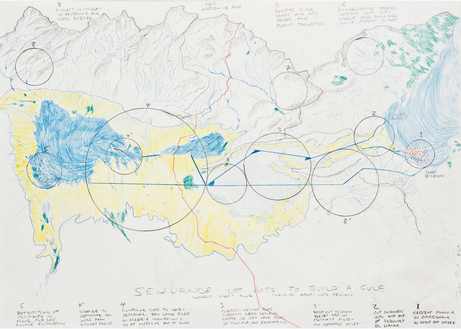
Peter Fend, Sequence of Acts to Build A Gulf, 2011
Please note that due to unfavorable weather conditions this event has been cancelled.
Volume 5 of the Graham-funded New Geographies journal aims to recast the Mediterranean as a contemporary phenomenon and spatialize its region-making processes as a larger geographic entity in the twenty-first century. On April 18, Antonio Petrov, editor-in-chief of Volume 5, considers major topics of the new issue with Sean Keller, Clare Lyster, and Hashim Sarkis in a panel discussion moderated by Stephen J. Ramos. A reception and book signing will follow.
New Geographies is a Harvard University Graduate School of Design journal that aims to examine the emergence of the geographic, to articulate it and bring it to bear effectively on the agency of design. As the synthesizing role that geography aspired to play among the physical, the economic, and the sociopolitical is now being increasingly shared by design, New Geographies encourages designers to reexamine their tools and develop strategies within the design disciplines.
Cofounder and editor of New Geographies, Antonio Petrov is a professor at the University of Texas in San Antonio. He is currently program director at Archeworks in Chicago, founder and editor-in-chief of DOMA, a bilingual magazine published in Macedonia, and the director of WAS, a think tank located in Chicago. Petrov’s research explores new discourses in regionalism and architecture with a focus on the Mediterranean. His book, Superordinary: New Paradigms in Sacred Architecture,is forthcoming. Petrov received his doctoral degree from Harvard University.
Sean Keller (Assistant Professor, Illinois Institute of Technology; Ph.D. Harvard University) is a historian and critic of modern and contemporary architecture. He has taught at Harvard and Yale universities and is a trustee of the Graham Foundation for Advanced Studies in the Fine Arts. He is a frequent contributor to Artforum and has written for numerous anthologies and journals, including Grey Room, Perspecta, Journal of Architectural Education, and Art Journal. He has two books forthcoming: Semi-Automatic: Motivating Architecture After Modernism (University of Chicago Press) and, with Christine Mehring,Munich ’72: Art and Architecture (Yale University Press).
Clare Lyster, Assistant Professor at University of Illnois at Chicago, is an architect, writer, and educator and founding principal of Claire Lyster Urbanism And Architecture (CLUAA) in Chicago. Her work explores the city from the perspective of its landscape and networks and the implications of this for architectural design. She is editor of Envisioning the Bloomingdale: 5 Concepts (Chicago Architecture Club, August 2009) and 306090 vol. 09 Regarding Public Space, with Cecilia Benites (Princeton Architectural Press, August 2005). Her writings have appeared in many publications including Cabinet, Journal of Landscape Architecture, Journal of Architectural Education and The Landscape Urbanism Reader and her design work has been exhibited locally and internationally including the Art Institute of Chicago. Current work toward a publication exploring the relationship between architecture and logistics was funded by a research grant from the Graham Foundation.
Stephen J. Ramos is an Assistant Professor in the College of Environment and Design at the University of Georgia. He is author of Dubai Amplified: The Engineering of a Port Geography (Ashgate Press,2010), and co-editor of Infrastructure Sustainability and Design (Routledge, 2012). He is a founding editor of the journal New Geographies and editor-in-chief of New Geographies Volume 1: After Zero (GSD/Harvard University Press, 2009). He received his Doctor of Design degree from Harvard University Graduate School of Design.
Hashim Sarkis is the Aga Khan Professor of Landscape Architecture and Urbanism in Muslim Societies at Harvard University Graduate School of Design. Sarkis is a practicing architect in Cambridge and Lebanon, working on urban and landscape projects. He has authored and edited many books and articles including Josep Lluís Sert: The Architect of Urban Design, 1953–1969 (coedited with Eric Mumford, 2008), Circa 1958: Lebanon in the Pictures and Plans of Constantinos Doxiadis (2003), CASE: Le Corbusier’s Venice Hospital (2001), and Projecting Beirut (coedited with Peter G. Rowe, 1998).
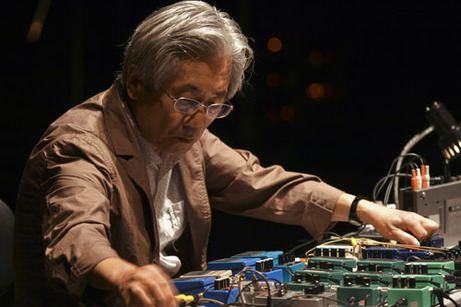
|
In this special solo performance, Takehisa Kosugi performs several compositions of multi-dimensional live electronic music including some shortened versions of longer work, most of which was originally commissioned for the Merce Cunningham Dance Company. Kosugi revises the material for quad sound using homemade audio generators, ready-made sound processors and light-sound interactive materials. The program includes Cycles (1981), Streams (1991), Op Music (2001), Music for Nearly 90, Part-A (2009), and Octet (2011). |
|
Takehisa Kosugi (b. 1938, Tokyo, Japan) is a composer for mixed-media music, and an early member of Fluxus. In 1960, he co-founded Group-Ongaku ("music group"), with Yasunao Tone, Mieko Shiomi, and others, the first collective improvisation group in Tokyo. While in New York from 1965 to 1967, Kosugi created new works in collaboration with Nam June Paik and other Fluxus members. In 1969 he co-founded the Taj Mahal Travellers, an itinerant septet for mixed-media improvisation that toured England, Europe and the Near East in 1971-72. Kosugi joined the Merce Cunningham Dance Company in 1977 as a composer and performer where he toured with John Cage and David Tudor. He was appointed music director in 1995, and worked with the company until 2011. Kosugi has received grants from The JDR 3rd Fund (1966 and 1977), a DAAD fellowship grant to reside in Berlin (1981), and the John Cage Award for Music from Foundation for Contemporary Performance Arts (1994). He has performed in countless international festivals, and his installations have been presented in exhibitions throughout the world. Kosugi performed in the Lampo series in March 2000, in concert with Jim O'Rourke at the Museum of Contemporary Art, Chicago. |
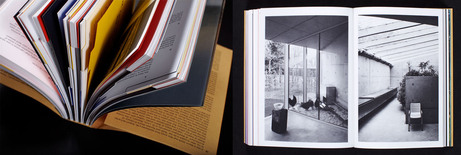
Wiel Arets: Autobiographical References and featured project Hedge House, Wijlre, the Netherlands, 1998-2001.
Wiel Arets: Autobiographical References (Birkhäuser, December 2012) offers a unique and unparalleled view of Arets, an internationally renowned architect and recently appointed dean of the College of Architecture at the Illinois Institute of Technology. Arets’ optimistic outlook towards the future, which he calls ‘A Wonderful World: A New Map of the World’, underlies his global philosophy. This new book presents Arets’ lectures on that topic, debates between him and other thinkers and makers, 60 exemplary designs from his studio, and an extensive series of interviews with Arets. Within these texts his background, education, projects, and teachings are interwoven in a discussion that highlights the evolution of his career.
At this book launch event, a discussion between Arets and Robert McCarters, editor of the book, will offer a comprehensive introduction to the work of Wiel Arets Architects. The talk will be followed by a reception in the Madlener House library where signed copies of the publication will be available for purchase.
Wiel Arets is a Dutch born architect, educator, industrial designer, theorist, and urbanist. Arets’ architecture and design firm, Wiel Arets Architects, has offices in Amsterdam, Berlin, Maastricht, and Zurich, and has been nominated numerous times for the European Union’s Mies Van der Rohe award. Before being appointed dean at IIT, Arets was dean of the Berlage Institute in Rotterdam from 1995-2002 and a professor of building, planning, and design at the Berlin University of the Arts.
Robert McCarter is a practicing architect, author, and Ruth and Norman Moore Professor of Architecture at Washington University in St. Louis. He previously taught at the University of Florida, where he was director of the School of Architecture from 1991-2001, Columbia University, University of Louisville, and North Carolina State University. He is the author of Understanding Architecture: A Primer on Architecture as Experience (with Juhani Pallasmaa, 2012); Wiel Arets: Autobiographical References (2012); Frank Lloyd Wright: Critical Lives (2006); Louis I. Kahn (2005); Frank Lloyd Wright (1997), and other books.
This event was originally scheduled for February 1, 2013.
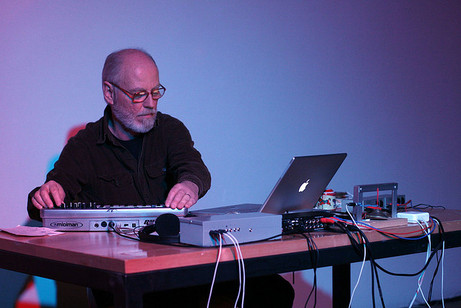
John Bischoff’s work is precise and textured, spare, and at times delicate. By juxtaposing a performer’s interactions with an analog circuit and raw digital audio generated from a laptop, Bischoff creates instances of pulsed and modulated sound that intimately combine the analog and digital. "In these pieces, the detailed nature of the performer's actions with the circuit—the initiation of sound events, the timing between them, and their spectral characteristics—are analyzed in real-time and used to construct an extended computer-generated response,” Bischoff explains.

David Hartt, for everyone a garden, image courtesy of Corbett vs. Dempsey, Chicago. © David Hartt
Graham-funded artists David Hartt and Karthik Pandian will discuss new work currently on view in two concurrent exhibitions in Chicago that both engage various strategies and critiques of 1960s avant garde architecture, art, and design practices with curator Hamza Walker. In his current exhibition for everyone a garden, Hartt references utopian projects by architects Moshe Safdie and Jean-Louis Chanéac from the late 1960’s to explore the complex relationship between form and ideology. Similarly, Pandian takes on 1960s artistic strategies in The Incomparables Club, the conclusion of a cycle of recent exhibitions that features the moving image and sound installation Reversal. Concerned with artistic labor, technologies of vision, and nostalgia for the avant-garde, previous iterations of the work took place in different forms at the Hammer Museum, Los Angeles and Vilma Gold, London in 2012.
Exhibitions:
David Hartt: for everyone a garden
Karthik Pandian: The Incomparables Club
On view through April 20, 2013
David Hartt was born in Montréal in 1967 and lives and works in Chicago. He graduated with an MFA from the School of the Art Institute of Chicago in 1994. His exhibition Stray Light is currently on view at the Studio Museum in Harlem and will travel in the fall to the Henry Art Gallery, Seattle and in 2014 to the Carnegie Museum of Art, Pittsburgh. He has had solo exhibitions at the Museum of Contemporary Art, Chicago (2012), Golden Age, Chicago (2011); Howard House, Seattle (2009); Deven Golden Fine Art (1998, 1997); Andrew Kreps, New York (1996); L’Observatoire-Galerie, Brussels (1995); and Ten in One, Chicago (1995). In 2012 he was named a United States Artists Cruz Fellow. He is a 2012 recipient of a Louis Comfort Tiffany Foundation Award. Hartt’s exhibition, for everyone a garden is on view at Corbett vs. Dempsey until May 11, 2013.
Karthik Pandian has had solo exhibitions at the Whitney Museum of American Art, New York; Midway Contemporary Art, Minneapolis; White Flag Projects, St. Louis; and Richard Telles Fine Art, Los Angeles amongst others. In 2013, his work will be featured in exhibitions at the Palais de Tokyo, Paris and Wiels Contemporary Art Centre, Brussels. Pandian's work has been supported by grants from the Graham Foundation for Advanced Studies in the Fine Arts, the Durfee Foundation and in 2011, he was the recipient of a Louis Comfort Tiffany Foundation Award. Pandian’s exhibition, The Incomparables Club is on view at Rhona Hoffman Gallery, Chicago through April 20 and the moving image and sound piece Reversal, will remain on view in the second floor space through June 1.
Since 1994, Hamza Walker has served as Director of Education/Associate Curator for The Renaissance Society at The University of Chicago - a non-collecting museum devoted to contemporary art. Recent exhibitions he has curated include Black Is, Black Ain’t, (2008), Several Silences, (2009), Anna Shteynshleyger, a survey (2010), The Age of Aquarius (2011), William O’Brien, a survey of the ceramics (2011), Anne-Mie Van Kerckhoven: In a Saturnian World, (2011), Local Metrics (2012), and John Neff, Photographs 2010-2012 (2013).. He was the recipient of the 2005 Walter Hopps Award for curatorial achievement, a 2006 Emily Hall Tremaine Award for the exhibition Black Is, Black Ain’t, and the 2010 Ordway Prize. He has written for numerous artists’ monographs in addition to publications such as Artforum and Parkett. Walker is the president of Graham Foundation for Advanced Studies in the Fine Arts board of trustees.
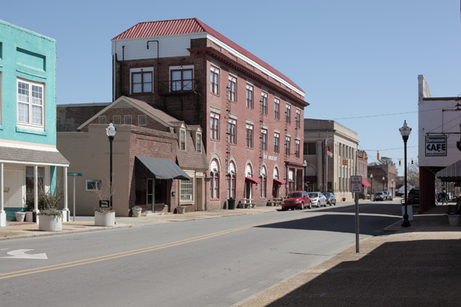
Mathias Heyden and Ines Schaber, Selma, North Carolina, USA, 2010 re/visited with Henry Sanoff.
Please join us to celebrate the opening of Where If Not Us? — Participatory Design and Its Radical Approaches. The exhibition will open with remarks from architect Mathias Heyden, artist Ines Schaber, and Graham Foundation director Sarah Herda followed by a reception.
6PM Opening Remarks
6-8PM Reception
For more information on the exhibition, Where If Not Us? Participatory Design and Its Radical Approaches, click here.
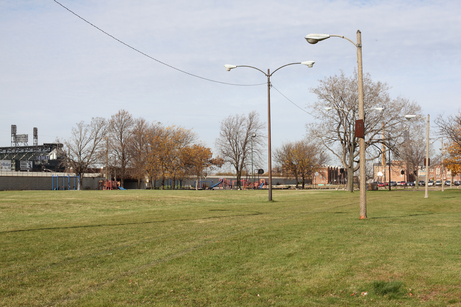
Mathias Heyden and Ines Schaber, Wentworth Gardens, Chicago, Illinois, USA, 2011, revisited with Roberta Feldman. (A demolished public housing site at State Street remains in front of new affordable housing and the Chicago White Sox stadium.)
Please join us for a public discussion with architect Mathias Heyden and artist Ines Schaber about their Graham-funded research and exhibition Where If Not Us? Participatory Design and Its Radical Approaches. Brief presentations by exhibition participants Roberta Feldman, Landon Bone Baker Architects, and Henry Sanoff will be followed by an open discussion about the past, present, and future of participatory design in Chicago and beyond.
Mathias Heyden is a Berlin-based architect, activist, organizer, author, curator, and co-founder of community project K 77. Currently he is an assistant professor and chair of Urban Design and Architecture at the Institute of Architecture, Technical University Berlin. Heyden is the author of numerous publications including Under Construction, Strategies of Participatory Architecture and Spatial Appropriation (with Jesko Fezer, 2003 - 2007) and the exhibition and magazines An Architecture 19-21: Community Design. Involvement and Architecture in the US since 1963 (with An Architektur, 2008).
Ines Schaber is an artist, photographer, and author living in Berlin, Germany. She studied fine art at the Academy in Berlin, architectural theory at Princeton University, and research architecture at Goldsmiths College, London. Her work addresses the relation of spatial and image politics. Her recent project Movers and Shapers (2001), in collaboration with the architect Jörg Stollmann, investigated the visual politics of master-planned communities in Arizona. In Picture Mining (2006) she explored the relation of historical labor photography to a photographic archive in a former limestone mine below an abandoned landscape in Philadelphia.
Roberta Feldman has been engaged in community design and research for more than thirty years. Embracing participatory design and action research practices, she has sustained working relationships with community leaders in over fifty community organizations and development corporations in Chicago’s low income neighborhoods to address their visions for shaping, revitalizing, and preserving their designed environments. Feldman co-founded the City Design Center in 1995 at the University of Illinois at Chicago. She worked individually as well as coordinated multi-disciplinary teams of students, faculty, and professionals in the fields of architecture, urban planning, graphic and industrial design, and history and culture of cities, to support communities underserved by the design professions. Through the City Design Center, Feldman has initiated numerous advocacy projects as well – forums, summits, exhibits, and websites – to raise awareness among professions and the public of the potential of design to serve public interest.
Landon Bone Baker Architects has served a diverse clientele by bringing community-based and environmentally responsible designs to complex urban environments in the Chicagoland area over the past twenty-five years. LBBA works on a range of project types, from affordable apartment rehabilitations to new single-family homes; from daycare centers to college libraries; and retail stores to office buildings. They approach each project as a team and extend this collaborative effort to client relations and technical consultants. Landon Bone Baker Architects is a hands-on, full-service architectural practice.
Peter Landon, founder and principal of Landon Bone Baker Architects, is known for his community-based, inner city planning, development, and design work. At a time when many architecture offices focused on high-end housing, Peter established Landon Architects Ltd., now LBBA, to balance affordable, public, and market rate projects. LBBA has delivered projects in Roseland, Lawndale, West Humboldt Park, Chinatown, Uptown, and Pilsen, and continues to support neighborhood revitalization efforts across Chicago.
Jeff Bone is a principal in Landon Bone Baker Architects. He is a registered architect in Illinois and Wisconsin and has managed a wide variety of affordable and supportive housing projects throughout Chicago and in Champaign and Urbana. He is currently working on the Viceroy SRO, an 89-unit development that explores green strategies for the historic preservation and adaptive reuse of a 1920s-era building and incorporates an urban farm and teaching kitchen for residents.
Catherine Baker joined Landon Bone Baker Architects in 1994 and was named a principal in 2002. While at LBBA, she has managed various projects including new and renovated single-family housing, multi-family housing, interior office build-outs and a daycare center. Currently she is managing several Hope VI revitalization programs in Chicago. The Hope VI programs include the complete redesign and master planning of neighborhoods where former high-rise housing projects once stood. She is also currently managing the redevelopment of the large project-based Section 8 housing project in Chicago’s Woodlawn neighborhood.
Henry Sanoff is an architect and professor emeritus of architecture at the School of Architecture, College of Design, North Carolina State University, and was the founder and director of the Community Development Group (CDG). Sanoff taught courses related to community participation, social architecture, design research, design methodology, and design programming. His research has concentrated in the areas of social housing, children’s environments, community arts, aging populations, and community participation. Sanoff has extensively published, he conducts workshops worldwide, and is a consultant for various participatory design firms.
Funding for Where If Not Us? has been provided by the Graham Foundation for Advanced Studies in the Fine Arts and the Institut für Auslandsbeziehungen.
For more information on the exhibition, Where If Not Us? Participatory Design and Its Radical Approaches, click here.
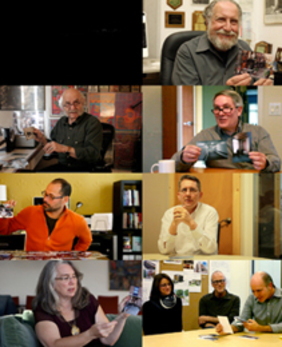
From top, left to right: Ronald Shiffman, Henry Sanoff, Graham Adams, David Perkes, Michael Rios, Roberta Feldman, Catherine Baker / Peter Landon / Jeff Bone.
Please join us for a dedicated screening of Where If Not Us? Participatory Design and Its Radical Approaches. This 100 minute video piece, made for our current exhibition, showcases selections from in depth interviews with each individual and group included in architect Mathias Heyden and artist Ines Schaber’s multi-stage research project about the development and future of participatory design in the United States. Offering an investigation of each protagonist’s position on questions about radicality in the field of community design, the film is comprised of conversations with Henry Sanoff, Graham Adams, David Perkes, Michael Rios, Roberta Feldman, Landon Bone Baker Architects, Ron Shiffman and Roger Borgenicht, Brandy Brooks, Monica Chadha, Kathy Dorgan, Daniel J. Glenn, Sharon Haar, Shally W. Harrison, Jeffrey Hou, and Alan J. Plattus.

The Pruitt-Igoe Myth tells the story of the wholesale changes that took place in the American city in the decades after World War II, through the lens of the infamous Pruitt-Igoe housing development in St. Louis. Destroyed in a dramatic and highly publicized implosion, the Pruitt-Igoe public housing complex has become a widespread symbol of failure amongst architects, politicians, and policy makers. At the film's historical center is an analysis of the massive impact of the 1949 Housing Act, which resulted in American cities being emptied of their residents, business and industry. And yet, despite its complex history, Pruitt-Igoe has often been stereotyped, with help from a world-famous image of its implosion, and used as an argument against modernist architecture or public assistance programs. The Pruitt-Igoe Myth seeks to set the historical record straight, to examine the interests in Pruitt-Igoe's creation, to re-evaluate the rumors and the stigma, and to implode the myth.
Chad Freidrichs has produced and directed two feature-length documentary films through his production company Unicorn Stencil Documentary Films. The first Jandek on Corwood (2003), documented the mystery and cult following of an underground musician. Its second film First Impersonator (2006), followed presidential look-alikes as they navigated the 2004 election and chronicled the rise and fall of famed John F. Kennedy impersonator Vaughn Meader. Freidrichs's films have screened at fifty film festivals including South by Southwest and Silverdocs, and played in seventy-five cities. In addition to making documentary films, he is on the faculty of Stephens College in Columbia, Missouri, where he teaches courses in advanced film production and film criticism. He has also made numerous corporate videos and more than 1,000 commercials.
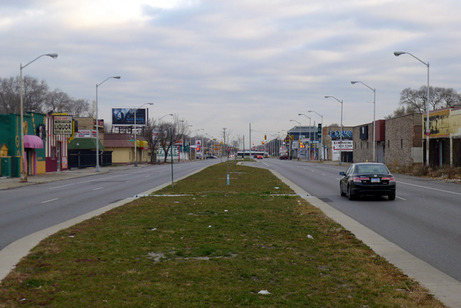
Livernois Corridor - Detroit's Next Hot Spot?
The nature of community development has evolved beyond the creation of long-term plans. Please join us as Monica Chadha and Virginia Stanard discuss how they create catalysts for communities through immediate actions and multidisciplinary partnerships in their work at Impact Detroit and in other neighborhood initiatives. Following the talk, Where If Not Us exhibition participant Michael Rios will start a brief discussion.
Monica Chadha is an architect and an Adjunct Assistant Professor at Illinois Institute of Technology. Her practice addresses community revitalization. In 2009, Chadha co-founded Converge:Exchange and she is currently developing Impact Detroit:, a partnership with the Detroit Collaborative Design Center (University of Detroit Mercy). Chadha was previously a Project Manager at Studio Gang Architects and Ross Barney Architects. At IIT, Chadha has led a community engagement design studio focused on the redevelopment of Bronzeville (Chicago) and several core studios. She has presented at several conferences and has most recently been published in Reveal, Princeton Architectural Press 2010. Chadha received her Masters of Architecture degree from the University of Illinois at Chicago, and a Bachelor of Environmental Studies in Architecture from the University of Waterloo, Canada.
Virginia Stanard is the Director of Urban Design at the Detroit Collaborative Design Center and Co-Director of the Master of Community Development program at the University of Detroit Mercy. She holds master’s degrees in Architecture and Urban Design from the University of Michigan and a bachelor’s degree in Architecture from the University of Virginia. Through practice and teaching, she advocates community development through the collaborative design process. At the DCDC, Virginia has developed economic and physical revitalization strategies at a range of scales and for a range of clients - including cities, philanthropic foundations, neighborhood groups, and developers. Recent projects include a greenway and development plan for daylighting the Bloody Run Creek on Detroit’s east side. Other projects include a development plan for Detroit’s Paradise Valley Cultural District, planning for Detroit Future City (formerly the Detroit Works Project Long Term Planning initiative), and revitalization strategies for Detroit’s 48217 and Woodbridge neighborhoods.
Impact Detroit, an initiative of the Detroit Collaborative Design Center (DCDC) at the University of Detroit Mercy School of Architecture, was launched in 2011 to support Detroit’s capacity for community development. It is an initiative that provides expertise, knowledge, and resources to help implement community-driven strategies as they relate to the built environment. Impact Detroit will form a collective hub leveraging the interdisciplinary expertise of professionals, local organizations, emerging leaders and community stakeholders to foster collaboration and realize local projects.
Converge: Exchange is a platform for communities, activists and practitioners to share innovative design strategies in local economies and for the built environment.
Michael Rios is an associate professor in the Department of Environmental Design and Chair of the Community Development Graduate Group at UC Davis. Formerly, Rios was the director of the Hamer Center for Community Design and the president of the Association of Community Design. Projects visited include: Organizing Public Interest Design, 1997-1999, revisited 2010 (Union Point Park, Oakland); A Public Transport Hub Becomes a Zócalo for Multiple Publics, 1995-1998, revisited 2010(Plaza del Colibri, San Francisco).
For more information on the exhibition, Where If Not Us? Participatory Design and Its Radical Approaches, click here.
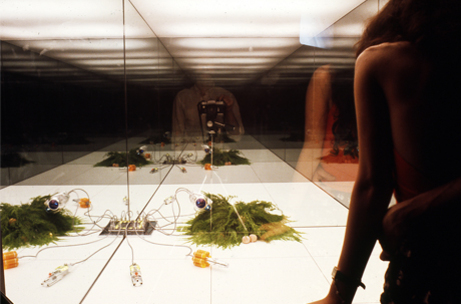
Microevent/Microenvironment, 1972. Photograph by Cristiano Toraldo di Francia, courtesy of Emilio Ambasz.
Please join us to celebrate the opening of Environments and Counter Environments. "Italy: The New Domestic Landscape,” MoMA, 1972 with curators Luca Molinari, Peter Lang, and Mark Wasiuta.
6PM - Discussion with exhibition curators
6:30-8:30PM - Opening Reception
For more information on the exhibition, Environments and Counter Environments. "Italy: The New Domestic Landscape,” MoMA, 1972, click here.
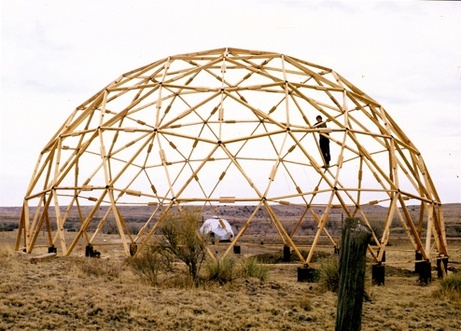
Theater Dome under construction, 1966
Drop City is the first feature-length documentary film about the artists who created a community of iconographic dwellings from the scrapheap of a wasteful society. Drop City's practices of art, architecture and sustainable living influenced a generation. Inspired by new theories and performances by Allan Kaprow, John Cage, Robert Rauschenberg, and others at Black Mountain College, the Droppers created a form of conceptual art based on performance, random interactions, and found materials. Their experimental buildings and creative practices became a model for alternative communities throughout the world. In 1966, Buckminster Fuller honored Drop City with his Dymaxion Award for "poetically economic structural accomplishments." The Droppers were at the forefront of what is now called "techno-culture"—a do-it-yourself ethos of decentralized technology. The story is told through a stunning array of film footage, photos, and interviews with Drop City's former residents, including artists, poets, inventors and activists.
Joan Grossman is visiting professor at the University of Missouri, Kansas City. She is a media artist whose work spans public radio, documentary film, and video installation. Her work has been screened and broadcast in more than twenty countries. Her award-winning film The Port of Last Resort was broadcast by HBO.
Tom McCourt is an associate professor of media at Fordham University. He is the author of Conflicting Communication Interests in America: The Case of National Public Radio (Praeger, 1999) and coauthor (with Patrick Burkart) of Digital Music Wars: Ownership and Control of the Celestial Jukebox (Rowman and Littlefield, 2006). He first encountered the story of Drop City more than twenty years ago and has researched its history and significance for several years.
Print Source: 7th Art Releasing
Drop City
http://grahamfoundation.org/grantees/207-drop-city
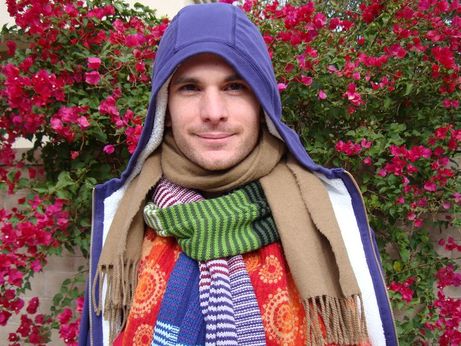
Lampo and the Graham Foundation are pleased to welcome Ben Vida, who will screen a new video work and premiere a four-channel electronics piece created especially for the event. In Tztztztzt Î Í Í…Vida presents the video realization of his long form sound poem of the same title, voiced by Sara Magenheimer, Tyondai Braxton, and Vida himself. Combining images of the vocalists’ performance with synthesized translations of these vocalizations, Vida explores the relationships between video and audio inputs and outputs. By doing so, his work aims to recalibrate the viewer’s senses, drawing attention to the processes by which we receive and decode information, and as Vida writes, “the brain’s ability to create order out of multi-sensory distortions.”
Vida will also perform Damaged Particulates, a new composition for fixed and live electronics presented in four-channel-expanded stereo. Organized into eleven short movements, Damaged Particulates derives its compositional strategy from the concept of “Particulate Systems Construction,” emphasizing the morphology and spatialization of single and dual-voiced sonic particulates. Although minimal in elements, Vida’s composition is at once sonically dense, grossly visceral, and disjunctively rhythmic. Here, sound objects take on an almost physical presence within the performance space, allowing spatialization to become a compositional material and discordant sonic composites to complicate traditional compositional logic.
Ben Vida (b. 1974, Dubuque, Iowa) is an artist, improviser, composer, and writer based in Brooklyn, NY. He has been active in the international experimental music scene for the past seventeen years with a long list of collaborations, bands, and releases to his credit. He is the co-founder of the group Town and Country and has worked as a solo artist, releasing records under his own name and the moniker Bird Show on labels including PAN, Alku, Thrill Jockey, Drag City, Amish, Bottrop-Boy, Hapna, and Kranky. Vida has presented his work in the United States, Canada, the United Kingdom, Europe, Australia, South Korea, and Japan. Recent activities include performances at the Kitchen in New York with David Behrman, the debut of the Tyondai Braxton/Ben Vida Duo at the Sacrum Profamun festival in Krakow, a solo performance at Electrónica en Abril festival in Madrid, and the publication of his long form sound poem Tztztztzt Î Í Í ... by Shelter Press. Vida’s first solo exhibition, Slipping Control, opened at Audio Visual Arts in New York this past spring. He is currently an Artist in Residency at ISSUE Project Room and at the Clocktower in New York.
This performance is presented in partnership with Lampo. Founded in 1997, Lampo is a non-profit organization for experimental music, sound art, and intermedia projects. Visit www.lampo.org.

"National Home Advertisement," Life Magazine 37, 11 (September 13, 1954): 139.
Architectural historian Dianne Harris discusses her Graham-funded book Little White Houses: How the Postwar Home Constructed Race in America (University of Minnesota Press, 2013). Examining textual and visual representations of ordinary postwar houses in the United States, Harris uncovers the production of an extraordinarily powerful iconographic and cultural field that repeatedly equated ordinary single-family houses with middle-class and white identities to the exclusion of others, creating an invidious cultural iconography that continues to resonate today.
Please join us for a reception and book signing in the Madlener House library following the talk.
Dianne Harris is director of the Illinois Program for Research in the Humanities (IPRH) and professor of landscape architecture, architecture, art history, and history at the University of Illinois, Urbana-Champaign. She holds a PhD in architectural history from the University of California, Berkeley. Her scholarship, which has a broad temporal and geographic reach spanning from 18th-century Lombardy to the postwar United States, is united by a constant interest in the relationship between the built environment and the construction of racial and class identities. In addition to her numerous scholarly articles, her publications include the co-edited volumes Villas and Gardens in Early Modern Italy and France (Cambridge University Press, 2001) and Sites Unseen: Landscape and Vision (University of Pittsburgh Press, 2007). She is editor of a multidisciplinary volume titled Second Suburb: Levittown, Pennsylvania (University of Pittsburgh Press, 2010), which won the Allen Noble book award from the Pioneer America Society. She is the author of The Nature of Authority: Villa Culture, Landscape, and Representation in Eighteenth-Century Lombardy (Pennsylvania State University Press, 2003), which received the Elisabeth Blair MacDougall Award from the Society of Architectural Historians in 2006 and of Maybeck’s Landscapes: Drawing in Nature (William Stout Publisher, 2005). She is also the recipient of a 2006 Iris Foundation Award from the Bard Graduate Center, New York for outstanding scholarly contributions in the history of art, decorative arts, and cultural history. Harris is a past-president for the Society of Architectural Historians, for whom she also served as editor-in-chief of the Mellon Foundation-funded digital humanities initiative SAHARA and she is series editor for the University of Pittsburgh Press. Harris currently serves as chair of the Advisory Board for the Temple Hoyne Buell Center for the Study of American Architecture at Columbia University and she is a board member for the International Built Works Registry, a project co-developed by Columbia University’s Avery Library and the ARTstor Digital Library.
This lecture is co-sponsored by the Society of Architectural Historians.
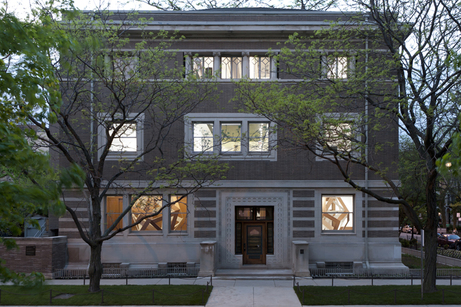
The Graham Foundation is pleased to be part of Open House Chicago, a free public event organized by the Chicago Architecture Foundation that offers behind-the-scenes access to 150 buildings across Chicago. Since 1963 the Graham Foundation has been located in the Madlener House, a Prairie-style mansion built in 1901–02 by architect Richard E. Schmidt and designer Hugh M. G. Garden. The Madlener House was restored in 1963 to become the Graham’s headquarters and features two floors of exhibition space, original art glass windows, and a courtyard garden that showcases our significant collection of late nineteenth- and early twentieth-century architectural fragments. On Saturday and Sunday, October 19–20 from 9am–5pm, come tour the Madlener House, visit our current exhibition Environments and Counter Environments. “Italy: The New Domestic Landscape,” MoMA, 1972¸ and check out our new architecture bookshop conceived by Chicago-based designer Ania Jaworska.
Image: View of “Anne Tyng: Inhabiting Geometry,” 2011, Graham Foundation, Chicago. Photo James Prinz.
For more information on the exhibition, Environments and Counter Environments. "Italy: The New Domestic Landscape,” MoMA, 1972, click here.
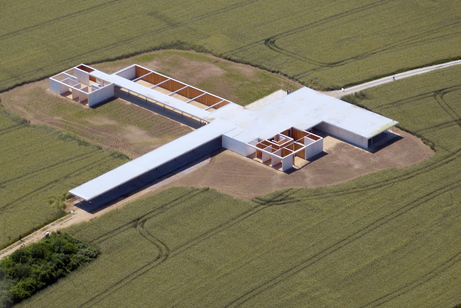
MIES 1:1 Das Golfclub Projekt © Frank Werthebach, 2013
In 1930, Mies van der Rohe, at the height of his European career, designed a golf clubhouse on the outskirts of Krefeld, Germany. While Mies’s design was never realized, this year Belgian architects Robbrecht en Daem and the Mies in Krefeld (MIK) Society constructed MIES 1:1 The Golf Club Project—a full-scale model of the clubhouse at the originally planned site in Krefeld. Based on sketches and plans from MoMA’s Mies van der Rohe Archives, MIES 1:1 was conceived as a site of investigation into Mies’s legacy and architectural language, his work in Krefeld, and the idea of the “model” in architecture and art.
On October 23, project curator Christiane Lange, architect and artistic director Paul Robbrecht, and curator Julian Heynen will give a series of related presentations about MIES 1:1. Lange will explore the historical background of Mies’s original design and the various meanings and public reception of the 1:1 model. Robbrecht will discuss his approach to the model’s source materials and how he approximated the 80-year-old designs. Lastly, Heynen will situate the 1:1 model within the broader context of architectural and artistic strategies.
Julian Heynen studied art history and literature and is currently Artistic Director at Large of the Kunstsammlung Nordrhein-Westfalen, Düsseldorf. He was co-curator of the Shanghai Biennale in 2008 and commissioner of the German Pavilion at the Venice Biennale in 2003 and 2005. In the 1980s and 1990s he was Director of Exhibitions at Kunstmuseen Krefeld, curating many shows of contemporary art at Haus Lange and Haus Esters, two villas designed by Ludwig Mies van der Rohe in 1927-1930. Heynen has curated numerous exhibitions of the works of artists including: Bruce Nauman, Thomas Schütte, Franz West, Andreas Gursky, Juan Muñoz, Richard Deacon, Thomas Struth, Lothar Baumgarten, Luc Tuymans, Rosemarie Trockel, Stan Douglas, Thomas Ruff, Daniel Richter, Rodney Graham, Candida Höfer, Martin Kippenberger, and Roman Ondák, as well as many group exhibitions. He has written widely on contemporary art since the 1960s. Heynen is based in Düsseldorf and Berlin.
Christiane Lange holds master’s degrees in art history and history from the universities at Bonn and Regensburg. She is a founding member of “projektMIK,” Krefeld, Germany. Her research, exhibitions and films focus on the European work of Mies van der Rohe and Lilly Reich.As a member of the German Research Foundation, Lange catalogs all furniture designs, realized and un-realized, by Ludwig Mies van der Rohe. Lange’s most recent publication is titled Mies van der Rohe, Bauten für die Seidenindustrie (Berlin, 2011).
Paul Robbrecht received his degree in architecture at HSLI, Ghent in 1974. In 1975 he co-founded Robbrecht en Daem architecten with Hilde Daem. Since 1992 he has been Professor of Architectural Design at HSLI, Ghent. Robbrecht is a member of the Royal Flemish Academy of Belgium for Science and the Arts and an International Fellow of Royal Academy of British Architecture (RIBA). Robbrecht and Daem were finalists for the 2013 European Union Prize for Contemporary Architecture / Mies van der Rohe Award for their project Market Hall - Reconstruction Korenmarkt, E. Braunplein and surroundings, Ghent.
This event is presented in partnership with the Goethe-Institut Chicago and the Mies van der Rohe Society at the Illinois Institute of Technology.
Projekt Mies in Krefeld
http://www.projektmik.com/
Robbrecht en Daem
http://www.robbrechtendaem.com/

The Graham Foundation is pleased to welcome architect and designer Emilio Ambasz, curator of MoMA’s groundbreaking 1972 exhibition Italy: The New Domestic Landscape, and Mark Wasiuta, co-curator of the Graham’s current exhibition Environments and Counter-Environments, for a talk on October 31, 2013. Following an introduction by Mark Wasiuta, Emilio Ambasz will read two texts that critically reflect on the historic 1972 exhibition.
Emilio Ambasz is an Argentinean architect and designer. He received his Bachelor and Master of Architecture degrees from Princeton University. From 1969 to 1976, Ambasz was Curator of Design at the Museum of Modern Art in New York, where he developed numerous influential exhibitions on architecture and design. Ambasz’s architectural projects, which explore the poetic potential and public value of natural landscapes, include the San Antonio Botanical Conservatory (1988), the ACROS Fukuoka Prefectural International Hall (1994), and the Banca dell’Occhio in Mestre-Venice, Italy (2009).
Mark Wasiuta teaches at the Graduate School of Architecture Planning and Preservation, Columbia University where he is the Director of Exhibitions and Co-Director of the Masters of Science in Critical, Curatorial and Conceptual Practices in Architecture (CCCP). He studied at the University of British Columbia, Princeton University, and Harvard University. His research focuses on postwar environmental design, an area of shared interest at the base of his collaborative office, the International House of Architecture. He is the recipient of recent grants from the Graham Foundation, the Canadian Social Sciences and Humanities Research Council, and the Banff New Media Institute. Recent curated and designed exhibitions include, Tony Oursler, UFOs and Effigies, No Longer Art: Salvage Art Institute, Collecting Architecture Territories, and Operators’ Exercises: Open Form in Film and Architecture. He is co-editor and co-author of Dan Graham’s New Jersey, and has recent articles published in Domus, Art Lies, Praxis, Journal of the Society of Architectural Historians, and Explorations.
For more information on the exhibition, Environments and Counter Environments. “Italy The New Domestic Landscape,” MoMA, 1972, click here.
Image: Italy: The New Domestic Landscape, 1972. Photograph by Cristiano Toraldo di Francia, courtesy of Emilio Ambasz.
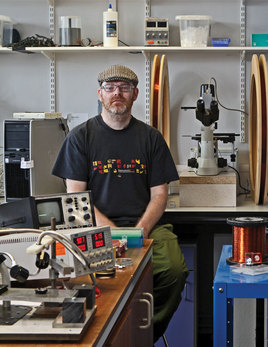
In his Chicago solo debut, Mark Fell presents new tonal work from music he developed as guest composer at the historic Elektronmusikstudion in Stockholm.
Fell is widely known for combining popular music styles, such as electronica and techno, with more academic approaches to computer-based composition that draw on algorithmic and mathematical systems. His recent musical practice is increasingly informed by non-European musics, evident in two linked works, Multistability and UL8, which explore a number of unfamiliar timing and tuning systems. In addition to recorded works, Fell produces installation pieces, often using multiple speaker systems. Although well versed in the use of ambisonics, his work in this area is characterized by “non-illusion based” approaches, where multiple wave shapes are spatially distributed to form complex synthetic sonic environments.
Mark Fell (b. 1966, Rotherham, England) is a multidisciplinary artist based in Sheffield, England. After studying experimental film and video art at Sheffield City Polytechnic, he reverted to earlier interests in computational technology, music, and synthetic sound. In 1998 he initiated a series of critically acclaimed collaborative and solo record releases on labels including Mille Plateaux, Line, Editions Mego, Raster Noton, and Alku. Fell received an honorary mention in the digital music category at Prix ARS Electronica (Linz) and was shortlisted for the Quartz award for his contribution to research in digital music. He has also been involved in several academic research projects, including a 2003 project led by British Algorist Ernest Edmonds at Loughborough University in the UK which explored the philosophy of technology in relation to contemporary art.
This performance is presented in partnership with Lampo. Founded in 1997, Lampo is a non-profit organization for experimental music, sound art, and intermedia projects. Visit www.lampo.org.
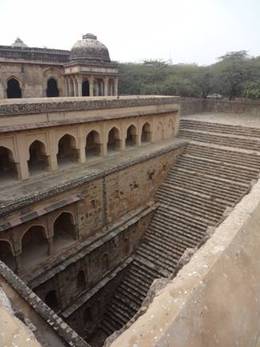
Rajon ki Baoli, Rajasthan, India.© Victoria Lautman.
Stepwells are a form of architecture unique to South Asia that first appeared in rudimentary form in India between the 2nd and 4th centuries A.D. Sunk deep into the earth, these underground edifices not only harvested and preserved water, but also functioned as civic centers, temples, cool retreats, and caravan stops. However, as many stepwells have been barricaded, filled in, repurposed, or altogether destroyed, they are quickly disappearing from historic record.
Journalist Victoria Lautman is a frequent traveler to India and former contributing editor for Architectural Record, Metropolitan Home, HG, Art+Auction, and Chicago magazine. In India, she’s written for The Hindu, Architectural Digest, Vogue, and GQ. Her writing about India has also appeared in Town & Country, ArchDaily.com, and The Huffington Post. Lautman’s long-running radio programs were heard on WFMT and WBEZ.
This talk is co-sponsored by AIA Chicago and Society of Architectural Historians.
Society of Architectural Historians
http://www.sah.org/conferences-and-programs/events-and-opportunities/2013/09/25/subterranean-ghosts-india-s-vanishing-stepwells
AIA Chicago
http://www.aiachicago.org/events.asp#November2013
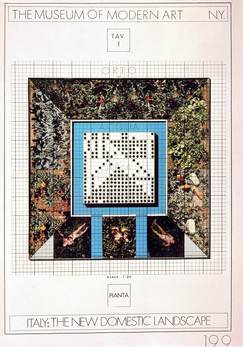
The Graham Foundation is pleased to welcome architect Carlo Caldini, one of the founding members of Italian avant-garde Gruppo 9999. Caldini will discuss the history and philosophy of Gruppo 9999, including its contributions to MoMA’s 1972 exhibition Italy: The New Domestic Landscape.
Founded in 1967 by Giorgio Birelli, Carlo Caldini, Fabrizio Fiumi, and Paolo Galli while they were students of architecture at the University of Florence, Gruppo 9999 was conceived as a research and work group dedicated to architectural experimentation and sustainability. Its large-scale projects and environments brought to the forefront questions of ecology, global transformation, and man’s relationship to the environment. Notably, in 1972, Gruppo 9999 won MoMA’s “Competition for Young Designers” with its project the Vegetable Garden House. Included in MoMA’s ground-breaking exhibition Italy: The New Domestic Landscape, the Vegetable Garden House developed out of Gruppo 9999’s earlier experiments conducted in Space Electronic, an avant-garde discothèque the group founded and designed in Florence in 1969.
Carlo Caldini (b. 1941, Florence, Italy) is a Florence-based architect whose work combines professional practice, teaching, and academic research. In 1964, together with architects Mario Preti and Walter Natali, he travelled extensively in India to study Chandigarh and other Indian cities. From July 1967 to February 1968, he and Preti visited the United States and Canada to study new university campuses. The program was sponsored by the Council on Leaders and Specialists, Bureau of Educational and Cultural Affairs, US Department of State.
For more information on the exhibition, Environments and Counter Environments. “Italy The New Domestic Landscape,” MoMA, 1972, click here.
Image: 9999, Bedroom for the Vegetable Garden House, 1972. Courtesy of 9999 Archive. Environments and Counter Environments. "Italy: The New Domestic Landscape," MoMA, 1972.
Support for this presentation has been provided by the Graham Foundation for Advanced Studies in the Fine Arts in collaboration with the Italian Cultural Institute of Chicago.
For more information on the exhibition, Environments and Counter Environments. "Italy: The New Domestic Landscape,” MoMA, 1972, click here.
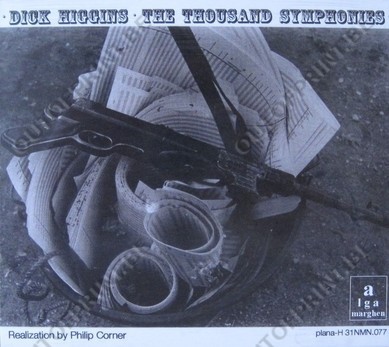
The Graham Foundation is pleased to present a live performance of The Thousand Symphonies, a seminal work by Fluxus artist Dick Higgins. In 1962, Higgins wrote a series of events called Danger Music, which were designed to alternately put the body of the performer, composer, or audience member at risk. In 1968, he realized one of these pieces by having a New Jersey police officer fire a machine gun at a few hundred sheets of orchestral music paper. An ensemble later played the holes. An act of simultaneous destruction and creation, the gesture emphasized the use of guns for a purpose other than killing Viet Cong and scattering protestors.
Recently, Rosenthal Fine Art, in collaboration with the Dick Higgins Estate, arranged with the City of Chicago to have four Chicago Police officers shoot new notation paper. On November 21 at the Graham Foundation, a live orchestra led by Stephen Burns will play the new sheets following the presentation of a short film documenting their creation. The ensemble will borrow the form of Stravinsky's L'histoire du Soldat (The Soldier’s Tale),with instruments from every section of the orchestra, plus electric guitar, which effectively updates the orchestration.
Special Thanks to the Chicago Police Department, James and Susan Allen, and to the Fulcrum Point New Music Project ensemble:
Stephen Burns, artistic director/conductor
Janice Misurell-Mitchell, flute
Lewis Kirk, bassoon
Jeremy Ruthrauff, saxophone
Andy Baker, trombone
Tina Laughlin, percussion
Alison Attar, harp
Steve Roberts, electric guitar
Reiko Seko, violin
Collins Trier, bass
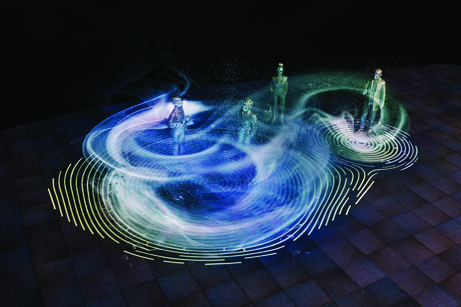
New Architecture Typologies (Proof 001). © WEATHERS / Sean Lally LLC.
Architect Sean Lally will discuss his Graham-funded book The Air from Other Planets: A Brief History of Architecture to Come (Lars Müller Publishers, 2013)—a speculation into an architecture produced by designing the energy within our environment (electromagnetic, thermodynamic, acoustic, and chemical). This architecture exchanges the walls and shells we have assumed to be the only type of attainable architecture for a range of material energies that develop shapes, aesthetics, organizational systems, and social experiences. In this world, energy emerges as more than the substance that simply fills the interior of a building or reflects off its outer walls. Instead, energy becomes its own enterprise for design innovation: it becomes the architecture itself.
Please join us for a reception and book signing in the Graham Foundation bookshop following the talk.
Sean Lally is the founder of Chicago-based design office WEATHERS/ Sean Lally LLC. Recent projects include proposals for the Gdansk Museum of WWII; an extension to the Stockholm City Library; and a proposal for the urban redevelopment of Reykjavik, Iceland. Lally was co-editor and contributor to Softspace (Routledge, 2007) and guest-editor of Energies: New Material Boundaries (Wiley Press, 2009). In 2011–12, he received the Rome Prize from the American Academy in Rome and in 2012, he received the Architectural League Prize for Young Architects and Designers. He is currently assistant professor at the University of Illinois at Chicago’s School of Architecture.
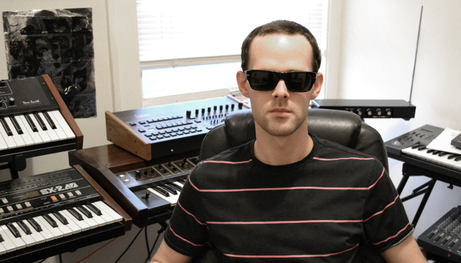
Cleveland-based artist Steve Hauschildt premieres music made in part by gesture—translating movement into sound. In his first multimedia performance using Buchla Lightning as his instrument, Hauschildt will conduct “music in a three-dimensional field.” Designed by synthesizer pioneer Don Buchla, this specialized controller operates on the principles of optical triangulation. Tiny infrared transmitters, built into two handheld wands, transform data, including velocity, acceleration, and pitch, into MIDI signals that are sent directly to synthesizers and electronics, allowing Hauschildt to control the system through gesture as opposed to a traditional keyboard.
Steve Hauschildt (b. 1984, Cleveland, Ohio) is an electronic musician and founding member of the band Emeralds (2006-2013). He has performed throughout North America, Europe, and Japan and has collaborated with Daniel Lopatin of Oneohtrix Point Never, Hollywood sound designer/composer Alan Howarth and Aaron Dilloway of Wolf Eyes, among others. His discography includes Tragedy & Geometry (Kranky, 2011), Sequitur (2012) and most recently, S/H, (Editions Mego, 2013), a two-disc anthology of previously unreleased and rare works from the artist’s archives.
This performance is presented in partnership with Lampo. Founded in 1997, Lampo is a non-profit organization for experimental music, sound art, and intermedia projects. Visit www.lampo.org.
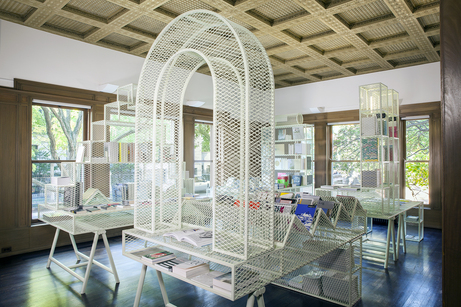
View of the Graham Foundation bookshop designed by Ania Jaworska, Chicago, 2013. Photo Travis Roozée.
The Graham Foundation is thrilled to announce the launch of its new architectural bookshop designed by Chicago-based Ania Jaworska. To celebrate, please join us for a reception and book sale. All books will be discounted up to 20% off or more!
Located in the former dining room of the foundation’s historic Madlener House, a 1901 Prairie style mansion in Chicago’s Gold Coast neighborhood, Jaworska’s installation is comprised of four bold mesh structures that display books and periodicals from the fields of architecture, design, art, and culture. In addition to recent hard to find publications, many titles are by the Graham Foundation’s international community of grantees and others are related to the Foundation’s exhibition program.
Ania Jaworska is an architect and educator. She currently teaches art, design, and architecture courses at the School of the Art Institute of Chicago and the University of Illinois at Chicago. She holds a master's degree in architecture from the Cracow University of Technology in Poland as well as the Cranbrook Academy of Art in Michigan. Her practice focuses on exploring the connection between art and architecture and her work explores bold simple forms, humor and commentary on conceptual, historic, and cultural references. Jaworska’s work was recently presented as part of 13178 Moran Street: Grounds for Detroit in Common Ground, the 13th International Architecture Exhibition in Venice (2012).
The installation was fabricated by Metal Magic.
Unless otherwise noted,
all events take place at:
Madlener House4 West Burton Place, Chicago
GALLERY AND BOOKSHOP HOURS
2025 Chicago Architecture Biennial
SHIFT: Architecture in Times of Radical Change
Sep 19, 2025–Feb 28, 2026
Wed–Sat, 12–5 p.m.
HOLIDAY HOURS: the galleries and bookshop are closed Dec 24, 2025 through Jan 3, 2026
Regular hours resume on Jan 7, 2026
CONTACT
312.787.4071
info@grahamfoundation.org
Accessibility
Events are held in the ballroom on the third floor which is only accessible by stairs.The first floor of the Madlener House is accessible via an outdoor lift. Please call 312.787.4071 to make arrangements.
Copyright © 2008–2026 Graham Foundation. All rights reserved.